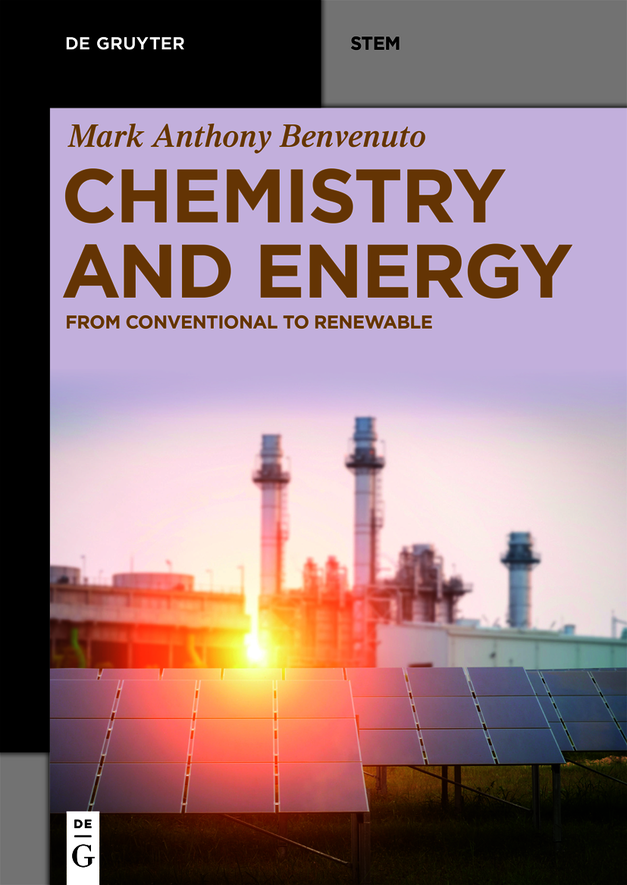Mark Anthony Benvenuto - Chemistry and Energy
Here you can read online Mark Anthony Benvenuto - Chemistry and Energy full text of the book (entire story) in english for free. Download pdf and epub, get meaning, cover and reviews about this ebook. year: 2021, publisher: De Gruyter, genre: Romance novel. Description of the work, (preface) as well as reviews are available. Best literature library LitArk.com created for fans of good reading and offers a wide selection of genres:
Romance novel
Science fiction
Adventure
Detective
Science
History
Home and family
Prose
Art
Politics
Computer
Non-fiction
Religion
Business
Children
Humor
Choose a favorite category and find really read worthwhile books. Enjoy immersion in the world of imagination, feel the emotions of the characters or learn something new for yourself, make an fascinating discovery.

- Book:Chemistry and Energy
- Author:
- Publisher:De Gruyter
- Genre:
- Year:2021
- Rating:5 / 5
- Favourites:Add to favourites
- Your mark:
- 100
- 1
- 2
- 3
- 4
- 5
Chemistry and Energy: summary, description and annotation
We offer to read an annotation, description, summary or preface (depends on what the author of the book "Chemistry and Energy" wrote himself). If you haven't found the necessary information about the book — write in the comments, we will try to find it.
Chemistry and Energy — read online for free the complete book (whole text) full work
Below is the text of the book, divided by pages. System saving the place of the last page read, allows you to conveniently read the book "Chemistry and Energy" online for free, without having to search again every time where you left off. Put a bookmark, and you can go to the page where you finished reading at any time.
Font size:
Interval:
Bookmark:

De Gruyter STEM
ISBN 9783110662269
e-ISBN (PDF) 9783110662276
e-ISBN (EPUB) 9783110662337
Bibliographic information published by the Deutsche Nationalbibliothek
The Deutsche Nationalbibliothek lists this publication in the Deutsche Nationalbibliografie; detailed bibliographic data are available on the Internet at http://dnb.dnb.de.
2022 Walter de Gruyter GmbH, Berlin/Boston
The history of humanity is tied up with the generation and use of energy. The world we live in today still uses some types of energy that it has used since antiquity, such as fire to cook food, even, if only at a summer outdoor gathering. But, obviously, there are numerous energy sources in use today that have only been harnessed and come into use in the past two centuries, and some that are much newer than that.
Even before humans had stopped being hunter-gatherers, we had started using and depending on a steady supply of energy beyond that furnished by our own muscles. Taming wood fires, the beginnings of which are lost in some ancient past, allowed people to cook food; and thus a wide variety of woods, grasses, and animal dungs were used in that process, and concurrently in keeping humans warm. In addition, as humans began to herd animals, the warmth of those animals was used to keep people and their dwellings warm in the evenings and in the cold seasons of the year. Importantly, the muscles of animals proved to be useful in doing work that would have been done by humans earlier work such as pulling a plow, a wagon, or a sled.
By the time humanity had begun to settle into permanent living areas those communities which would eventually become cities fire had been harnessed not only to keep people and animals warm but to smelt metals and to fire clay. The invention of both the kiln and the forge, and the use of coal to fire them, allowed advances in human life and the quality of that life precisely because the energy of fire was channeled into the production of specific materials, such as pottery and metal tools or weapons. Some modern artisans and craftsmen still utilize these ancient techniques, an example of which is seen in . In turn, fire was generated by the combustion of woods and animal dungs and at times by the hotter combustion of coal. It is not an exaggeration to claim that the use of fire in this manner helped bring certain peoples to the fore, and ultimately helped bring about the rise of city-states and empires.

Figure 1.1: Bronze sword.
The use of fire and its traditional fuels on a large scale had consequences that could not have been seen at the time it began. For example, the use of wood fires to heat homes at the start of the Industrial Revolution meant that some cities had an almost constant haze about them, and smelled as if there was some never-ending bonfire ablaze. Such use also deforested areas, sometimes large ones. In England, for example, for many years, it was against the law to fell large trees for such things as ].
But wood, animal dung, and coal were not the only sources of energy used in the distant past. Sailing ships and windmills certainly used the power of the circulating air, and the suns rays were harnessed to dry food, produce salt from brine ponds, and aid humans in several other ways. In addition, dams have a long history, both for storing water and for controlling its use [].
The idea of concentrated solar power is a relatively new one, in terms of producing energy, but also has an interesting historical footnote. According to legend, the famous Archimedes in the third century bc directed the use of polished bronze shields against a fleet of invading Roman ships. Supposedly the shields were directed so that the suns rays were concentrated at the ships, which eventually caught fire. The story, while a colorful and impressive example of a possibility for the use of concentrated solar power, is doubted by many historians today.
One chapter in solar energy that is not in doubt is the much more modern first solar collector patent, issued to Alessandro Battaglia, in 1886 [power has continued to find applications, either for generating small amounts of electricity, or large. But this also continues to struggle economically against the prices of coal and oil when it comes to feedstocks for materials that can generate the needed power.
Curiously, the idea of using a water wheel to produce and harness the power of flowing water goes far back before the use of it to generate electricity. Archaeologists and historians believe that the earliest water wheel, one driven by tidal water power, was at the Nendrum Monastery mill in Northern Ireland, and was in use as early as the year 787 ce . This remains a subject of debate, as water wheels have been mentioned in the writings of the ancient Greeks and Romans. Perhaps obviously, the use of any configuration of water wheel to generate electricity is a much more recent accomplishment [].
Wind power has a very old history as well, but for most of it wind was only used for some single mill or for a sailing ship. Much more recently, wind has been used to generate power for a larger, integrated power grid. shows part of a modern wind farm in southwest Ontario. Each tower rises several stories higher than the average home, and all are linked to the local power grid. The construction of such windmills and their internal mechanisms requires materials that have never before been required in such large quantities. An example is lanthanides, such as neodymium, which are used in motors of such windmills.

Figure 1.2: Wind farm.
There have been only a few points in history that one specific event or change in thinking has affected the world in large and all-encompassing ways. One can argue that the invention and spread of laws is one such event a means by which all people in a community are expected to act and behave in the same manner, and for which standard punishments are meted out for transgressions. The initial use and continuous spread of coins may be another the idea that some object or thing can be used as a common means of value for a variety of other objects of value, even when those objects are not located in the same place. But by far, the inception of what we now call the Industrial Revolution is one of those events that have changed history, on par with the long-term storage of different foods, taming of the horse, and even the rise of the Roman Empire.
The Industrial Revolution appears to have its origin in Great Britain. There remains debate as to what the dominant factor or factors were that started it, whether it was a surge in human population, or changes in farming, or changes in climate that brought about these just-mentioned two, some combination of the above three, or some other factors that we have not mentioned. What is not in doubt is that England sits geologically on one enormous bed of coal, one that could be reached with mining techniques that were known three centuries ago []. This buried material did become a source of power when it was burned in order to heat water, and the resulting steam is used to obtain useful work from steam turbines. One other source of power at the time was the water wheel.
Font size:
Interval:
Bookmark:
Similar books «Chemistry and Energy»
Look at similar books to Chemistry and Energy. We have selected literature similar in name and meaning in the hope of providing readers with more options to find new, interesting, not yet read works.
Discussion, reviews of the book Chemistry and Energy and just readers' own opinions. Leave your comments, write what you think about the work, its meaning or the main characters. Specify what exactly you liked and what you didn't like, and why you think so.





